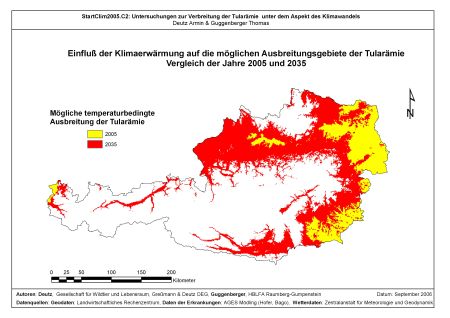From this data, an altitude-dependent temperature distribution was calculated for suitable monthly averages or period totals. Precipitation was calculated without the influence of altitude using the geostatistical method of universal kriging. A linear regression model could be created from the two climate parameters and the locally occurring cases of illness. What is notable is the highly significant (p < 0.05) influence of the selected parameters (number of diseased brown hares; average of the mean monthly temperature in December, January and February; mean monthly temperature in May; total rainfall in June and July) on the frequency of the diseases and the coefficient of determination achieved (R² ) of 74.6%.
Based on these findings, empirical limits were established for the parameters defined in the formula that best correspond to the actual spatial spread in geoanalysis. These limits define a high probability of tularemia occurring with an annual rainfall below 720 mm, a summer rainfall around 180 mm, a winter temperature above 0.5 ° Celsius and a May temperature below 14 ° Celsius.
For a forecast of the distribution area in 2035, climate warming of between 2 and 4 ° Celsius was assumed. The possible spread of tularemia in 2035 was then shown after the increase in the annual mean temperature. From the eastern lowlands, tularemia can slowly spread further to the west via the Danube valley and further to the south via southern Styria. In addition, cases are possible in favorable inner Alpine locations, which corresponds to a massive expansion of the potential tularemia distribution area.







